Housing
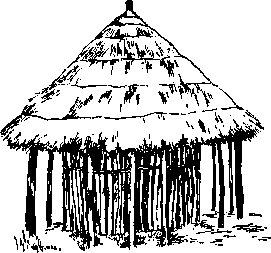 Ground
House
Ground
HouseA simple Tonga ground house with verandah. This is the typical type of dwelling one would find in a village. Recorded 1957; Chipepo village; (Reynolds 1968:15)
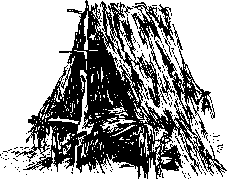 Garden
Shelter
Garden
ShelterThis is a garden shelter built with a low platform. This type of shelter is used to sleep in during the dry season when crops are maturing in the river bank gardens, away from the village. You would stay here to keep vermin, and hippopotamus from invading your fields at night. Recorded 1957; Sigongo village; (Reynolds 1968:15)
 Day
Shelter
Day
ShelterThis is a typical day shelter for use in the village or near the gardens. These serve as shady places to rest during the heat of the day when the sun is at its worst. Other tasks, such as grinding grain, cooking, etc. are carried out under the cover of these shelters. Recorded 1957; Chipepo village; (Reynolds 1968:15)
Food Storage Technology
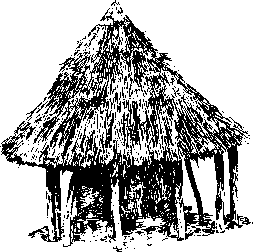 Mud
Granary
Mud
GranaryThis is an example of one type of mud-plastered granary used to store grains such as millet and sorghum. The peaked, thatched roof helps keep the rains out. The plastering helps to keep rats, birds, and other little thieves out of the food supply. Recorded 1957; Chipepo village; (Reynolds 1968:18)
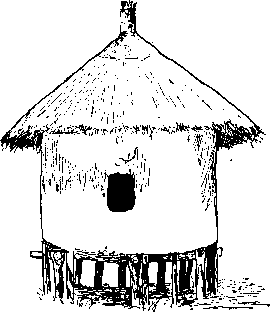 Mud
Granary
Mud
Granary This is another example of the mud-plastered granary. The small window is the only opening in the granary, and is intentionally kept small so that it is easy to block off to keep pests out. Recorded 1957; Chipepo village; (Reynolds 1968:18)
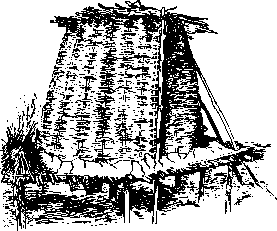 Wicker
Granary
Wicker
GranaryAs opposed to the previous granaries, this one has wall made of wickerwork, and is built on an elevated platform of poles and mud plaster. Note that this granary has not had its roof put on yet. Recorded 1957; Sigongo village; (Reynolds 1968:18)
The Valley Tonga practice what is called slash and burn or swidden agriculture. When a new field is cleared, the men lop the lower branches off the taller trees, and cut down the smaller trees. The branches and other refuse are then piled around the taller trees, as in this picture, and allowed to dry out. Then the area is burned. The burning brings down the tall trees, and returns a certain amount of nutrients to the soil. After a few years, the field will have to be abandoned, or fallowed, in order to recover its fertility. Riverbank and floodplain fields do not need to be fallowed, however, because the flooding river deposits new soil each year - automatically rejuvenating the fields.

Food Production and Processing Technology
These are examples of the kind of iron axes the men use in the process of clearing new fields. They have wide blades and short handles. The bulge where the head is hafted on the handle serves both to secure the head and as an added weight to make the axe more efficient. (Reynolds 1968:108)
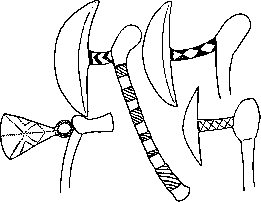
All planting and weeding is done with the traditional short-handled hoe shown here. Note the knob on the end of the handle to keep it from slipping out of the hand. The hoe, like the axe, is designed with extra weight behind the head so that it does not have to be swung as hard to do the job. The handles are typically less than three feet long. As a result, both planting and weeding require a great deal of stooping over. Think what your back would feel like after 8-12 hours of weeding with one of these!
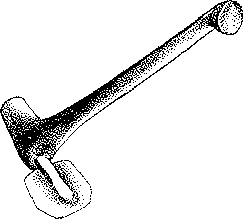
A typical Tonga wooden mortar for pounding grain. (Reynolds 1968:127)
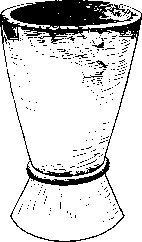
Wooden pestles used for pounding grain. Lengths: a- 36 inches (young girl's pestle); b- 57 inches (woman's pestle); c- 71 inches (used for pounding grain on an open floor). A woman's pestle is one of her most prized and customized belongings.
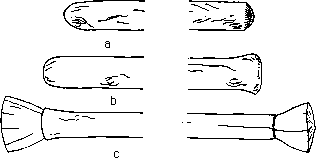
|
|
|
|